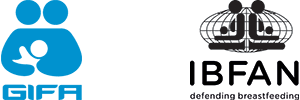
2023/07/31
Infant and young child feeding in emergencies
Natural and man-made disasters – earthquakes, floods, drought and war – regularly put human lives at risk. Among these people, babies and young children caught up in the turmoil are particularly vulnerable and at risk of malnutrition, illness and death.
See IBFAN’s Declaration at the World Health Assembly (WHA 76) 2023 and GIFA Newspost https://www.gifa.org/en/breastfeeding-in-emergencies/
Babies have special dietary needs and are born with compromised immune systems. Breastfed infants receive immune support in addition to food to protect them from the worst in emergency conditions. However, the situation is very different for babies who are not breastfed. In an emergency, the food supply is interrupted, clean water for bottle preparation and cleaning may be lacking, and the entire health care system is severely compromised. As a result, babies who are not breastfed become vulnerable to infection and the risk of diarrhea. Babies with diarrhea quickly become malnourished and dehydrated and are therefore at risk of death.
In an emergency situation, it is extremely important that babies who are already breastfed continue to breastfeed and that non-breastfed babies resume breastfeeding, or if this is not possible, receive breastmilk substitutes prepared as hygienically as possible. Children under five years of age, and especially those under two years of age, are also at risk of becoming ill more often and succumbing in emergency situations. Breastfeeding continues to protect these children, and the WHO recommends breastfeeding for up to two years or more. Young children also need sufficient nutritious food prepared safely – a real challenge in an emergency.
In the past, it has been found that huge quantities of breast milk substitutes have been given in emergencies. Calls for help may come from aid agencies, governments, the media, or individuals. In the confusion of emergency situations, these products are often distributed in an uncontrolled manner and used by mothers who would normally breastfeed their babies. As a result, many infants become ill or die unnecessarily.
Yet, there are internationally recognized guidelines for the organization and provision of infant feeding in emergencies (Operational Guidelines on Feeding Infants and Young Children in Emergencies 2017 IFE Core Group exist in multiple languages). Governments were called upon to follow them in a World Health Assembly Resolution on nutrition resolution on nutrition in 2010, to protect, promote and support optimal breastfeeding, as well as minimize the risks of artificial feeding by ensuring that necessary breast milk substitutes are procured, distributed and used according to strict criteria in emergencies.
Guidelines on infant and young child feeding in transit were also developed in October 2015 in response to the influx of migrants in Europe: Guidelines on IYC Feeding in Transit, working document by UNICEF, UNHCR and Save the Children, document for refugees and migrants in Europe, October 2015
Useful links
- Operational Guidance on Infant Feeding in Emergencies (OG-IFE) version 3.0 https://www.ennonline.net/operationalguidance-v3-2017
- Key messages: Protecting infants in emergencies: information for the media, Infant Feeding in Emergencies (IFE) Core group : Protéger les nourrissons en cas d’urgences : informations pour les média, Infant Feeding in Emergencies (IFE) Core group
- World Breastfeeding Week Feature 2009: Crisis Situations Dossier semaine mondiale allaitement maternel thème 2009 : situations de crise
- The Code and Infant Feeding in Emergencies, IBFAN & Emergency Nutrition Network Le Code et l’alimentation infantile en situation d’urgence,
- IBFAN fact sheet on infant feeding in emergencies
- Baby-friendly spaces: holistic approach for pregnant, lactating women, and their very young children. Action Contre la Faim (ACF) International, December 2014.
- News Post 2022: What do mothers in Ukraine need?
- 2023 IBFAN Statement at WHA76 (2023)
- 2018 Resolution on IFE Infant Feeding in Emergencies (A71.9)
- May 2022, IYCF_Joint-Statement Protecting Infant and Young Child Feeding Practices in the Ukraine Conflict and Refugee Crisis

